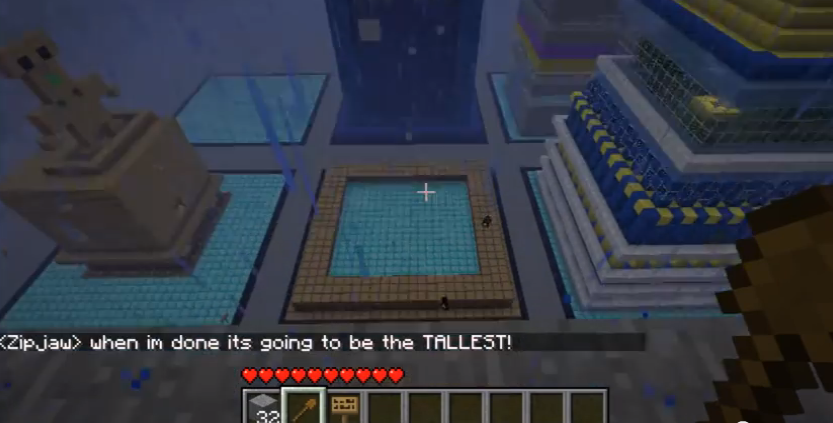The video link above shows a Minecraft construction challenge: a virtual, neutral environment. Six players, four active and two that may join the group later. Different skills, different ages, collaborating from remote location across the globe. Playing with clear rules and zero risks.
Minecraft is the revolutionary collaborative game developed by Swedish programmer Markus “Notch” Persson and later developed and published by the Swedish company Mojang since 2009.
The environment in which the game takes place is a low-resolution version of reality and the core action performed by players is the one of breaking and placing blocks.
The game has a night-time cycle equal to 20 minutes of real time. During the game day time non-hostile creatures such as animals and villagers spawn peacefully whilst hostile creatures such as spiders, skeletons and zombies spawn during nighttime or in dark places, such as caves.
One of the most interesting features of the game is that the game has no specific aim. The players do not have to kill each other nor to win a football match. The main concept is to use natural resources to build a shelter, collaboratively interacting with other players.
In the video linked above you can hear a young child speaking. He is one of the players. His skyscraper looks more like a house and it is the most practical and detailed design than any of the buildings created by the other players. His creation does not seem obsessed with being the tallest or the most colourful but inside he put a bed, a bath and some railway carts. Not quite sure about the railway carts, but the rest of his features looked to me as a sensible response to the need of building a liveable space more than breaking the world record for towers’ height.
Young or old alike, the virtual construction environment allows all players, through the anonimity of the Avatar, to have a saying in the construction process, regardless of their personal connection with the planning system, the landowners or the property developer. Not only public engagement seems to work better in the virtual world of construction compared to the real one but also creative problem solving, diversity, digital innovation and bridging the skills gap seem all resolved without effort.
Minecraft can do all this because is simple and fun. By simple we mean that the correlation between action and reaction is precisely scripted and all variables are generally well defined within the game code. By fun we mean that awards or penalties are dispensed in real time thus creating an engaging interactive experience.
The construction industry will never become as easy and as fun as Minecraft but what we should be learning from the game is that, by defining the rules of the game in a transparent way, more people are can take part in the game. We could do with some of that in our procurement models! We should also learn that by having real time tracking of the effect of our action we could dispense awards and penalties more quickly fostering best practice and limiting the bad ones. We could do with some of that in our the definition of value and the setting of LEAN targets and POE standards! Finally we should learn that by hosting open creative events in a digital environment we could truly unlock creativity across the supply chain having multidisciplinary teams coming together and finding a shared solution, testing various options and comparing results – at zero risk. Of course.
There are probably a few more lessons that we may learn from Minecraft. For now, let’s all try to understand that it is time to look outside our industry to learn something new.
The data coming from BIM level 2, if hosted on a public server, could provide the evidence required to inform real time feedback for design options tested in a virtual environment. In our previous blogpost Digitising the Planning System we suggested the possibility to re define the submission of planning applications as the simple upload of a BIM model with a standardised level of detail. By capturing design and operational data related to not only construction but also energy, air quality, crime rate and social capital we could effectively create a BIM based Minecraft environment. And possibly improve the resolution.
Time to go back to the too short lived definition of Built Environment as Construction is, clearly, much more than just Construction.

